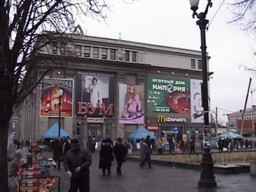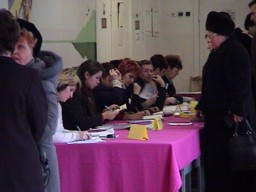

OSCE Repeat Second Round Ukrainian Presidential Election Observation Mission.
December 2004.


As STOs (short term observers) we were not allowed to go into exact detail of what we observed as an OSCE member until the OSCE prints its final report since their analysis will be far more thorough and balanced than any individual report could be. Complete information about the OSCE analysis of the recent Ukrainian presidential can be found at the OSCE's web site at: OSCE. As well, the final report from the Canada Corps is located here Canada Corps . However, as OSCE STOs we were allowed to describe our impressions on the overall atmosphere that surrounded our election experience.
This page lists my overview of the mission just after the election as well as a more thorough final report located here:==> Kostiuk Final OSCE Election Report .

The OSCE in Ukraine supplied the STOs (short term observers) with an election kit that required each two-person OSCE team to record various important observations on Election Day. Some teams were also assigned to monitor the activities of the Territorial Election Commissions (or TECs) and that meant staying there overnight often until noon the next day. I was part of an OSCE group that was assigned to the city of Dnipropetrovsk. We travelled there via the overnight train on the same evening as our OSCE orientation session in Kyiv. I was teamed with Aurore Chaigneau a law professor from Paris.
The city of Dnipropetrovsk was founded in 1787 by Count Potemkin on the order of Catherine the Great on the site of a kozak fortress. The founding took place a short time after the Kozaks and Russians had together fought against the Turks who were in possession of the Black Sea area. After the peace treaty the Russians took control of the rich farmland in the area. To this day the local people still take pride in their kozak heritage. The original name of the town was Ekaterinoslav, but in 1926 the growing city was renamed Dnipropetrovsk in honour of Grigoriy Petrovsky who was the first leader of the Ukrainian Soviet republic. The region has a population of 3.7 million and the main industries are heavy machinery, chemicals, food products as well as rockets. Leonid Brezhnev, Ukrainian President Kuchma as well as his son-in-law are from the Dnipropetrovsk region.
For the many rich citizens there are many expensive shops and high quality restaurants situated around the city's main street Karl Marx Prospect. The main square of the city is Lenin Square with contains a very large statue of Lenin. The square as well as many parts of the city is being transformed by the additions of many new modern structures. Construction cranes dot the skyline. The McDonald's restaurant is a very popular spot on the square as are the huge outdoor electronic advertising billboards, which display "loud" rock videos and an assortment of commercial messages to the delight of the young people who frequent the area. The city also has a very good streetcar/tram line that runs on dedicated "right of ways" and on very wide treed boulevards in the centre of the city. The tramlines also extend across the Dnipro River to the suburban and peri-urban areas. These trams lines and wide boulevards are a legacy of soviet city planning and most Canadian cities would love to have them. However, while the centre of the city appears to be booming the peripheral areas show signs of decay with poorly lit roads, and another problem are the disappearing manhole covers that are stolen and sold for scrap metal. Consequently, walking on the poorly lit streets is hazardous at night since the pedestrians must not only avoid the many speeding automobiles but also the many open manholes. For this reason various objects such as tires, large rocks and tree branches are placed in the manholes to warn both drivers and pedestrians of the unexpected hazards.

On the day before the December 26 vote our OSCE team consisting of Aurore, our driver, our interpreter and myself visited our assigned polling stations to let the polling station personnel know we were coming the next day. I dressed in proper business attire wearing an OSCE armband and with election observer accreditation clearly visible. Having worked in Ukraine before I know the importance of presenting oneself as a competent professional. At 7:30 on Election Day we went to our first polling station. We asked permission to take pictures and videos at every poll even though the election law allowed it. Throughout the day every polling station played loud, fun style (even disco) music and there were also bake sales in the lobbies of the schools. The idea here is that Election Day can be a fun day as well. With the exception of one nervous and agitated polling commissioner we were treated extremely well in our visits to the polling stations. Most of these visits were also recorded on my digital video camera.

Since there are 33,000 polling stations in Ukraine an accurate impression of the voting scene cannot be determined from just a few visits to polling stations throughout the day. That is why the true analysis and commentary of the accuracy and fairness of the election should only come from the headquarters of the various observer groups, which in my case are the OSCE and the Canada Corps.
However, one of the issues that did stand out in our visits was the problem of access that older and disabled people have in getting to the polling stations. All of the polling stations that our OSCE team visited were located in schools. And many of the polls were located on the second or even third floors of these schools. As well, in a winter election, night comes early and the suburban and rural streets often have no streetlights and it is dangerous to walk in these conditions. That is why some older people (in my opinion) did not get out to vote. Many of the manholes have also been stolen for scrap metal making nighttime walking a hazard to say the least. Perhaps having the election in the late spring or early fall would allow more people the ability to get to the polls. As well, moving the polls to the first floors and installing ramps at the entrance to the schools would help older and disabled people gain better access to their polling stations.
The common language in the region is Russian although most people understand Ukrainian. Ukrainian is also the language of instruction in Ukrainian schools. According to the OSCE the political situation in the region is somewhat complex. This is partly due to the fact that Yanukovich originates from neighbouring Donetsk, which is a regional rival to Dnipropetrovsk. Consequently, Yushchenko is supported by some elements of the Dnipropetrovsk business community who are in competition with businesses in the Donetsk region. In the "first" second round election Yanukovich received 60.94 %, Yushchenko received 31.02% and 6.39% voted for "against all". There is also a large student population attending the city's 26 universities and postsecondary institutions and it is presumed that many are opposition supporters. There was even a small protest-tent city situated near the Lenin statue.
Therefore, the vote split is not so much Ukrainian versus Russian as it is region against region and between the younger (who do not know communism) and the older generations (who are still thinking about the long-term linkages to Moscow). It is also not so much about whether there needs to be change in Ukraine but rather, what degree of change is needed and how quickly it should occur which is the real and ongoing issue. I feel fortunate that I was an election observer and look forward to other observer missions in the future.
Michael Kostiuk
Canadian OSCE STO Election Monitor, Repeat Second Round Ukrainian Presidential Election.
The Elections for President of Ukraine. Repeat voting on 26 December, 2004
The percent of protocols in Ukraine that have been processed 100.00
The number of voters who participated in voting 29,068,971
The percent of voters of the voters who voted against all 2.34
The number of votes cast for each candidate (Percentage and actual number )
Viktor A. Yuschenko 51.99 15,115,712
Viktor F. Yanukovych 44.20 12,848,528
Data courtesy of Ukraine's Central Election Committee.